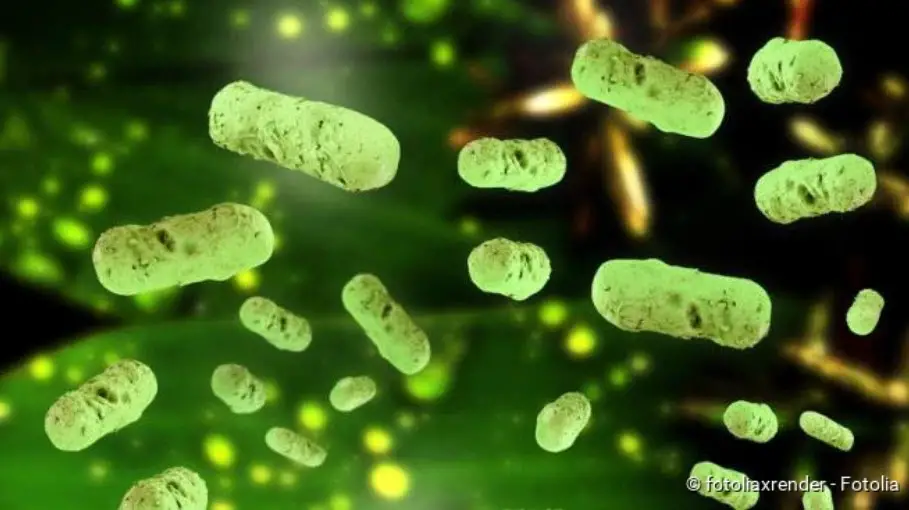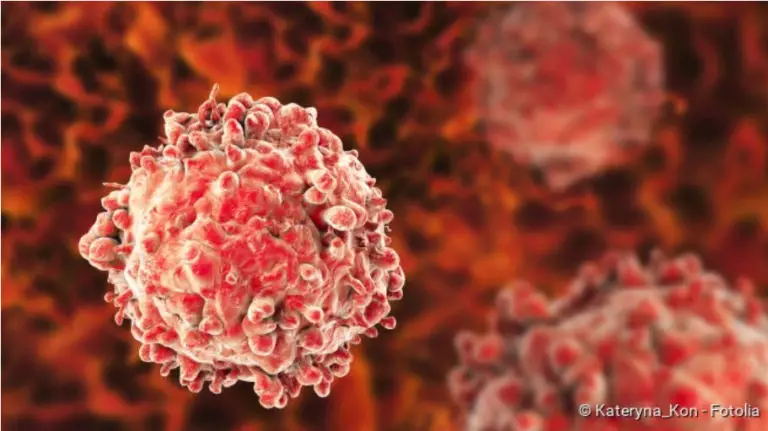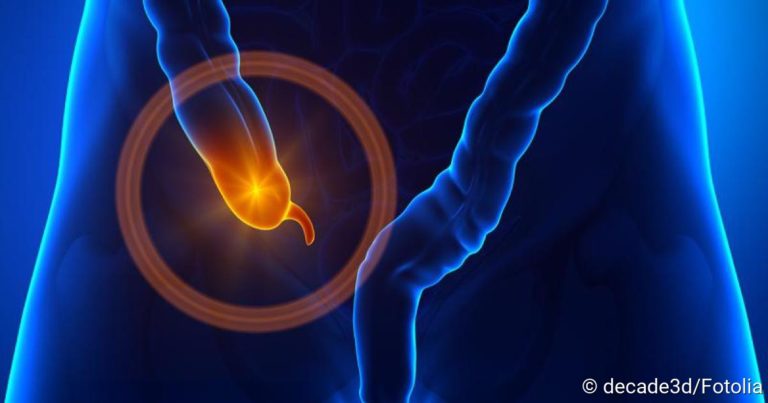Salmonella poisoning (salmonellosis): infection, symptoms, treatment
Salmonella poisoning (salmonellosis): infection, symptoms, treatment
Salmonella poisoning (salmonellosis) is an infection with salmonella. These bacteria can cause various diseases, including typhoid, paratyphoid and enteritis. A typhoid disease is always treated with antibiotics, an enteritis usually only in severe cases. Read more about salmonella poisoning here!

Salmonella poisoning: Description
Salmonella poisoning (salmonellosis) is generally an infection with salmonella, i.e. certain bacteria. It can take different courses – depending on the type of salmonella and the condition of the person affected. On the one hand, salmonella poisoning can manifest itself in the form of intestinal inflammation and, on the other hand, it can also manifest itself systemically (i.e. throughout the body) (typhoid disease).
What is salmonella?
Salmonella are mobile, rod-shaped bacteria that can penetrate cells. Two species are distinguished: Salmonella enterica and S. bongori. The first species, Salmonella enterica, is divided into six subspecies and over 2,000 so-called serovars, some of which cause different diseases. Some of these serovars carry proper names like:
- Salmonella typhi: typhoid fever
- Salmonella parathyphi (A,B,C): paratyphoid
- Salmonella enteritidis (and Salmonella typhimurium): Enteritiser
The causative agents of typhoid fever and paratyphoid fever only cause disease in humans. They enter the blood from the intestine, spread throughout the body via the bloodstream (systemic infection) and can cause dangerous blood poisoning (sepsis).
The enteritis pathogens occur in both humans and animals and usually do not leave the intestine. They cause diarrhea and vomiting.
Salmonella are able to survive for several months (even in the freezer) and adapt very well to their environment. This is particularly important for salmonella enteritidis: Salmonella enteritidis is frequently found in poultry. Defrosted poultry and also the thawing water can contain a large number of salmonella and thus easily lead to salmonella poisoning.
Salmonella poisoning: Frequency
Salmonella poisoning, already known in ancient times, gained in importance in the 19th and 20th centuries. By improving water supply, sanitation and hygiene and introducing antibiotics, such infections could be contained.
Salmonella enteritis is the one of the most common notifiable food-borne intestinal disease in the United States and the European Union after Campylobacter infection. This form of salmonella poisoning occurs mainly in small children and in summer.
An estimated 22 million people worldwide contract typhoid fever every year, 200,000 of whom die. The risk of disease is highest in India and Pakistan. Most cases occurring in Europe and the United States occur after travel to (sub)tropical areas. Paratyphoid fever, a disease similar to typhoid fever, is similarly rare in Western countries.
Salmonellosis must be reported
Any suspicion of salmonella enteritis, typhoid fever or paratyphoid fever must be reported to the public health department (reporting obligation) because salmonella is contagious. Also subject to reporting are the detected disease and death from salmonella poisoning.
Anyone working in schools, kindergartens or similar community facilities or in food processing companies may in certain cases be prohibited from working even if salmonella poisoning is suspected. The public health department monitors sick people and only allows them to work again when no more salmonella can be detected in three stool samples.
Salmonella poisoning: symptoms
Once the pathogens have been absorbed, it takes either hours to days (enteritis) or weeks (typhoid fever) before the first salmonella symptoms appear. The exact duration of this Salmonella incubation period depends on the type and quantity of bacteria ingested.
How severe the symptoms are is very variable. Some infected persons (especially those with a strong immune system) even show no salmonella symptoms at all (“silent salmonella infection”).
Enteritis
The pathogen, Salmonella enteritidis, prefers to settle in the small intestine and excrete toxins. They trigger the first symptoms five to 72 hours after salmonella poisoning: acute vomiting diarrhoea with severe abdominal cramps, fever and headache. A dangerous consequence of diarrhoea is dehydration (loss of water), as much fluid and electrolytes are lost. Salmonella symptoms usually improve after a few days. Sometimes the bacteria can also be detected in the blood (bacteremia) and settle in organs, especially in high-risk patients with weakened immune systems.
Typhoid & Paratyphoid
In contrast to enteritis, typhoid fever (abdominal typhoid fever) begins insidiously 3 to 60 days after the actual salmonella infection. A typical course of fever, a grey tongue (typhoid tongue), a swollen spleen and a skin rash are characteristic of typhoid fever. In addition, the transition from initial constipation to pea-like diarrhoea – also typical of this type of infection with Salmonella – is evident.
Signs of paratyphoid are usually weaker: About one to ten days after the infection, they often manifest themselves only as a gastrointestinal infection with watery diarrhoea, vomiting, nausea and fever. After four to ten days, the symptoms of Salmonella usually subside – much faster than with typhoid fever.
Spread of infection
Salmonella poisoning can expand in the body and cause severe inflammation (especially in typhoid and paratyphoid fever): after passing into the blood, the bacteria can settle in all organs and cause severe infections. The gall bladder and spleen are particularly frequently affected.
A recurrence (relapse) shortly after salmonella poisoning is usually due to insufficient antibiotic therapy.
Salmonella poisoning: causes and risk factors
Salmonellae are preferably infected by eating contaminated food or by contact with infected persons. By definition, Salmonella infection is possible until three negative stool samples have been detected.
Infection with salmonella enteritis
Salmonella enteritidis is most frequently found on raw eggs and in insufficiently heated meat (especially poultry, mussels, minced meat). Cross-contamination is also possible, i.e. the transfer of pathogens from such contaminated food to other products such as vegetables. Therefore, potentially contaminated food must be processed and stored separately.
Only rarely does salmonella poisoning occur via animals (especially pets such as reptiles) or excretors. Permanent eliminators are rare. Salmonella enteritidis usually does not leave the intestine and therefore rarely leads to inflammation of other organs.
Infection with typhoid fever and paratyphoid
People are usually infected with the pathogens of typhoid fever and paratyphoid fever by ingesting water and food contaminated with infectious faeces (urine, stool). Often the infection is also caused by hand contact with sick people or (unrecognised) salmonella permanent eliminators – people who also carry salmonella in their bodies permanently after an infection (without showing further symptoms) and excrete it with the stool.
The typhoid salmonellae reach the small intestine through oral intake. There they penetrate into the intestinal cells and – after passing into the blood – also into the macrophages. In the wall of the small intestine there are accumulations of white blood cells, the so-called Peyer plaques. Especially in this area an inflammation occurs, which can also lead to cell death (necrotic inflammation). This may explain the diarrhoea.
Risk Groups
Salmonella poisoning can have a severe course in risk groups such as infants, small children, the elderly or immunocompromised persons. For example, people with sickle cell anaemia, systemic lupus erythematosus, HIV infection or other immune deficiencies are at risk. In these patients, the gastric acid or defence system is not strong enough to kill the bacteria efficiently. Salmonellosis also often affects people who take stomach acid inhibitors.
Salmonella poisoning: examinations and diagnosis
The specialists for salmonella poisoning are gastroenterologists and also travel doctors. If there is a suspicion of mild salmonella poisoning, you can first consult your family doctor. In severe cases a hospital should be consulted. First, the doctor will ask the following questions, among others, in order to collect the medical history (anamnesis):
- Do you have a fever?
- How’s your bowel movement?
- Have you been travelling lately?
- Have you had contact with people who suffer or have suffered from salmonella?
- Are you taking any medicine?
Physical examination
This is followed by a physical examination. The doctor will examine the stomach in particular detail. In addition, it is very important in salmonella poisoning to recognise signs of dehydration (exsiccosis, dehydration) and to assess its severity. This dehydration results from the high loss of fluid and salt due to vomiting and diarrhoea.
Salmonella detection
In order to confirm salmonella poisoning, usually stool and blood samples from the patient are examined in the laboratory. Salmonella is also found in vomit, rectal swabs and contaminated food. In addition, typhoid Salmonella can also be detected from bone marrow, small intestine secretion and urine. The stool is often only positive for salmonella in the second to third week of illness, but can also remain negative throughout. For detection, Salmonella are either cultivated in the laboratory or a rapid test (such as the MUCAP test) is performed.
There are various methods (lysotyping, biochemical and genetic methods) for the exact typing of salmonella. These investigations are carried out at the National Reference Centre at the Robert Koch Institute (RKI). This allows the path of salmonella poisoning to be traced. In the case of an epidemic of salmonella poisoning, the results of those affected and the potential triggers can be compared.
In many cases of salmonella poisoning, additional tests are carried out to determine whether the causing salmonella are resistant to certain antibiotics.
Blood test
If typhoid fever is suspected, the blood should first be tested. In salmonella enteritis the stool is more important. The blood can be searched for antibodies against Salmonella (Widal test). However, the detection of antibodies is often not possible in the case of Salmonella poisoning. Typhoid and paratyphoid salmonella may also be detected in the blood (bacteremia); this is rarely the case with salmonella enteritis.
The blood sample also serves to detect an increase in inflammation parameters. In case of fever, a blood culture should be done: In salmonella poisoning, the number of white blood cells is reduced (leukopenia) and one of its subgroups, the eosinophilic cells, is completely absent (aneosinophilia). In addition, many white blood cells are immature (left shift). With paratyphoid fever, the number of white blood cells is increased.
Imaging
Computer tomography (CT) of the abdomen can reveal a thickened intestinal wall, especially at the transition from the small to the large intestine. Before this section the intestine may be dilated. However, these signs are not specific to salmonella poisoning – they may be similar to those of so-called pseudomembranous colitis (caused by Clostridia bacteria).
Differential diagnoses
Some symptoms of salmonella poisoning also occur with other diseases. For example, the doctor will check whether another food poisoning (especially one caused by staphylococci) causes the symptoms. Symptoms similar to typhoid fever can also occur in malaria, endocarditis, tuberculosis (especially in the stage of miliary tuberculosis) and other intestinal infections and inflammations (such as ulcerative colitis).
Salmonella poisoning: treatment
Salmonella treatment depends on the type of pathogen and the form and severity of the disease. While a typhoid disease is usually treated immediately with antibiotics, this is not always necessary in the case of salmonella enteritis. In all cases of salmonella poisoning, special hygiene regulations must be observed.
Treatment of Salmonella enteritis
The sudden vomiting diarrhoea in this form of salmonella poisoning requires careful control of the water and electrolyte balance. To compensate for the large loss of water and salts, patients can drink electrolyte or glucose solutions and adjust their diet accordingly. For infants and young children, glucose and electrolytes should be injected into the vein.
Antibiotics are given if the enteritis is severe or if the affected persons have a weakened immune system (such as infants, elderly people, patients with immune deficiencies and heart defects). They have little influence on the course of salmonella poisoning, but ensure prolonged salmonella excretion in the stool. Because the number of antibiotic resistances in salmonella poisoning is increasing, it is advisable to test for existing resistances beforehand.
Typhoid
This salmonella poisoning is combated with antibiotics. Currently, ciprofloxacin (and a broad-spectrum cephalosporin), among others, is recommended for a two-week salmonella treatment. But there are also other antibiotics that can be used. Strict hygiene rules must also be observed.
Particularly in Asia, resistance to the common antibiotics used against typhoid fever is becoming increasingly common. Therefore, even if typhoid fever is suspected, a test for resistance to antibiotics should be carried out.
After discharge from hospital, patients continue to be monitored by the health authorities until three consecutive stool samples are free of salmonella.
Salmonella permanent eliminator
Anyone who continues to excrete salmonella permanently after salmonella poisoning must be given special treatment. The antibiotic salmonella treatment with ciprofloxacin or ceftriaxone (with gentamicin) must be continued for one month and two weeks respectively. In the case of so-called small bowel excretions, lactulose is often added. If the salmonella have settled in the gallbladder, it can be surgically removed. However, this is now only rarely done.
Salmonella poisoning: course of disease and prognosis
Salmonella poisoning, if treated correctly, usually heals without consequences. The prognosis in individual cases depends on many factors such as the age and constitution of the patient. Serious complications are more frequent in people with a weak immune system (especially small children and old people). Deaths due to complications of salmonella poisoning are rare in Germany. The following applies to typhoid fever: 15 to 20 percent of patients die untreated. If, on the other hand, treatment is given, the mortality rate is less than one percent.
Complications of salmonellosis
Especially because of the high fluid loss a collapse or even circulatory failure can occur. This in turn can lead to kidney or heart failure. Other possible consequences of salmonella poisoning are intestinal bleeding, ulcers and intestinal ruptures. A strong suspicion of intestinal rupture arises if the body temperature suddenly drops during the course of the disease.
If salmonella circulates in the blood, the risk of salmonella poisoning being carried forward increases: the inflammation can spread to the lungs, gall bladder (cholecystitis), liver (hepatitis), bones (osteomyelitis), brain (meningitis), heart (endocarditis) and other organs. In severe cases there is a risk of blood poisoning (sepsis). Another possible complication is a so-called reactive arthritis, a joint disease.
Salmonella permanent eliminator
Permanent salmonella eliminators are people who continue to excrete the pathogens via the stool after their recovery. In typhoid fever, about two to five percent of patients become such permanent eliminators. In contrast, this is very rare in salmonella enteritis. The permanent eliminators of typhoid fever are divided into so-called bile eliminators (salmonella are released with the bile) and small intestine eliminators. Bile excretors have an increased risk of gallbladder cancer.
Salmonella poisoning: prevention
The most important measure to protect against salmonella poisoning is adequate drinking water and food hygiene. Food that may contain salmonella (such as meat) should be stored separately from other food and at less than 10 degrees. Their preparation should also be carried out separately, for example to avoid transferring salmonella to raw vegetables. The defrost water should also not come into contact with other food. Poultry, fish and other meat should be fried well. In this way contained salmonella can be killed. Minced meat should not be stored for more than one day. Food containing raw egg should be eaten as soon as possible. Especially in risk areas the rule is: “Cock it, peel it, boil it or leave it!”
Hands should be washed and also disinfected regularly.
Permanent salmonella eliminators and acutely ill patients in Germany are obliged to observe special hygiene measures and are not allowed to work in contact with food. Special precautions also apply to work in community facilities.
Vaccinations
Vaccination against the typhoid fever pathogen can be carried out when travelling to high-risk areas, during epidemics and natural disasters. Similar to a past illness, there is a certain immunity after a typhoid vaccination – but it does not protect 100 percent from infection. The vaccination can either be given as an oral vaccination (taking three capsules at two-day intervals). Or the vaccination against typhoid salmonella poisoning is administered as an injection.





